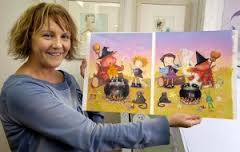Wednesday, February 11, 2015 Let's face it: some kids just don't like to read. Increasingly, parents, teachers, librarians, and editors are looking for books that will appeal to reluctant readers. When I was writing The Best Books for Kids Who (Think They) Hate to Read (Random House), I read hundreds of children's books, old and new, that I thought would fit the bill. I discovered that there are eight qualities possessed by great books for reluctant readers, and to my surprise some of my childhood favorites didn't pass the test. If you can work at least three of the elements listed below into your book, it will have a good chance of being loved by all kids, even those to whom reading is a chore.
Let's face it: some kids just don't like to read. Increasingly, parents, teachers, librarians, and editors are looking for books that will appeal to reluctant readers. When I was writing The Best Books for Kids Who (Think They) Hate to Read (Random House), I read hundreds of children's books, old and new, that I thought would fit the bill. I discovered that there are eight qualities possessed by great books for reluctant readers, and to my surprise some of my childhood favorites didn't pass the test. If you can work at least three of the elements listed below into your book, it will have a good chance of being loved by all kids, even those to whom reading is a chore.
* Humor. Making kids laugh is essential to building a pleasant association with reading. But you need to understand what tickles kids' funny bones at different ages. The humor in picture books is broad and very visual. Easy readers (and some picture books for ages 6 and up) begin to introduce verbal humor: wordplay, puns, double meanings. As kids move into the chapter book arena they can handle jokes that need a setup and a payoff that's played out over several scenes. Dialogue, how characters react to each other, or the situation in which a character finds himself may be innately humorous.
* Well-Defined Characters. Many kids want to identify strongly with the characters in their books; for reluctant readers, this is essential. It doesn't matter what the character looks like on the outside (be it space alien, a clown or a talking frog), on the inside this character needs to embody the perspective of the reader. This means the character is dealing with issues the reader might face, or seeing the world in a childlike way. Book characters must have multidimensional personalities with strengths and weaknesses in order for the reader to care about them and want to stick with them for the entire story. In nonfiction such as biographies, authors who find an element of their subject's life that is relevant to the target audience have a better chance of reaching reluctant readers.
* Fast-Paced Plot. Kids who love to read don't mind a story that takes a few chapters to unfold, but reluctant readers don't have that much patience. The action needs to start in the first paragraph, and by the end of the first chapter the reader should know quite a bit about the main character and have a good idea about the conflict or problem that character will face. Subplots are fine for chapter books and up, but too many will get in the way of the forward movement of story. Keep the pages turning.
* Concise chapters. Ideally, each chapter should contain one clear event (or one specific point in nonfiction), and have an arc of its own (a beginning, middle and end). This makes reading even one chapter a satisfying experience. Chapters that end on a high note in the action will make the reader want to see what happens next. Episodic novels (where each chapter stands alone as a short story) are also good bets for reluctant readers. Richard Peck's A Long Way from Chicago and Louis Sachar's Sideways Stories from Wayside School are two middle grade examples.
* Kid Relevance. This applies to the themes and ideas that form the basis for plots or how an author approaches a nonfiction topic. These ideas should be relevant, meaningful, and applicable to the reader's life. Instead of conveying a lesson your adult perspective tells you the reader needs to know, try using the reader's frame of reference as a starting point. Write to your audience, not at them. And remember, books can be just for fun.
* Suitable Text. Depending on the age and ability of the reader, the text needs to be challenging but not overwhelming. Strive to write your story as clearly as you can, using active sentences and concrete nouns and verbs. When writing for a broad age range of reluctant readers (8-12, for example), make the vocabulary accessible to the younger end, but the interest level appealing to kids on the older end of the spectrum.
* Unique Presentation. Reluctant readers often choose nonfiction over fiction because it speaks to their personal interests. Finding a new or unusual slant to your topic helps keep that interest alive. Humor doesn't hurt either. It's Disgusting and We Ate It! True Food Facts from Around the World by James Solheim appeals to middle graders' love of the gross while sneaking in some history on the side.
* Visual Appeal. Authors generally don't have much say in a book's design, but author/ illustrators might. Larger typeface, the generous use of white space, and illustrations that elaborate upon the text all help break up the string of words and make the book less intimidating to read.